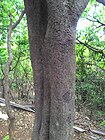Note: This is a project under development. The articles on this wiki are just being initiated and broadly incomplete. You can Help creating new pages.
Difference between revisions of "Meyna laxiflora"
| Line 2: | Line 2: | ||
'''Meyna laxiflora''' is a species of flowering plant in the family Rubiaceae. It has a world-wide distribution across tropical and subtropical regions. | '''Meyna laxiflora''' is a species of flowering plant in the family Rubiaceae. It has a world-wide distribution across tropical and subtropical regions. | ||
==Uses== | ==Uses== | ||
| − | {{Uses| | + | {{Uses|Inflammation}}, {{Uses|Gastrointestinal disorder}}. |
| + | |||
==Parts Used== | ==Parts Used== | ||
{{Parts Used|Fruits}}, {{Parts Used|Leaves}}. | {{Parts Used|Fruits}}, {{Parts Used|Leaves}}. | ||
==Chemical Composition== | ==Chemical Composition== | ||
| − | The chemicals reported from the plant belong to different classes such as carbohydrates, starch, proteins, tannins, saponins and alkaloids. <ref name="chemical composition"/> | + | The chemicals reported from the plant belong to different classes such as carbohydrates, starch, proteins, tannins, saponins and alkaloids.<ref name="chemical composition"/> |
==Common names== | ==Common names== | ||
Revision as of 17:30, 23 June 2020
Meyna laxiflora is a species of flowering plant in the family Rubiaceae. It has a world-wide distribution across tropical and subtropical regions.
Contents
- 1 Uses
- 2 Parts Used
- 3 Chemical Composition
- 4 Common names
- 5 Properties
- 6 Habit
- 7 Identification
- 8 List of Ayurvedic medicine in which the herb is used
- 9 Where to get the saplings
- 10 Mode of Propagation
- 11 How to plant/cultivate
- 12 Commonly seen growing in areas
- 13 Photo Gallery
- 14 References
- 15 External Links
Uses
Inflammation, Gastrointestinal disorder.
Parts Used
Chemical Composition
The chemicals reported from the plant belong to different classes such as carbohydrates, starch, proteins, tannins, saponins and alkaloids.[1]
Common names
| Language | Common name |
|---|---|
| Kannada | Mullakare, Gobergally |
| Hindi | Muyna, Pundrika |
| Malayalam | NA |
| Tamil | Manakkarai |
| Telugu | Visikilamu, Chegagadda |
| Marathi | NA |
| Gujarathi | NA |
| Punjabi | NA |
| Kashmiri | NA |
| Sanskrit | Pindituka |
| English | Muyna |
.[2]
Properties
Reference: Dravya - Substance, Rasa - Taste, Guna - Qualities, Veerya - Potency, Vipaka - Post-digesion effect, Karma - Pharmacological activity, Prabhava - Therepeutics.
Dravya
Rasa
Guna
Veerya
Vipaka
Karma
Prabhava
Habit
Identification
Leaf
| Kind | Shape | Feature |
|---|---|---|
| Simple | Ovate-oblong | Leaves are arranged oppositely or whorls of three. Strong spines are bent at an acute angle. |
Flower
| Type | Size | Color and composition | Stamen | More information |
|---|---|---|---|---|
| Greenish-white | Flower cymes occur in leaf axils, fascicled on a short peduncle. Flowers are small. The stigma is 4-5-lobed. | {{{5}}} |
Fruit
| Type | Size | Mass | Appearance | Seeds | More information |
|---|---|---|---|---|---|
| 5-6 long, oblong-reniform | Yellow | Fruit is of the size of a cherry, turbinate, smooth, when ripe, succulent. |
Other features
List of Ayurvedic medicine in which the herb is used
Where to get the saplings
Mode of Propagation
How to plant/cultivate
Direct sowing of seeds.[4]
Commonly seen growing in areas
Photo Gallery
References
External Links
Categories:
- Ayurvedic Herbs known to be helpful to treat Inflammation
- Ayurvedic Herbs known to be helpful to treat Gastrointestinal disorder
- Herbs with Fruits used in medicine
- Herbs with Leaves used in medicine
- Herbs with common name in Kannada
- Herbs with common name in Hindi
- Herbs with common name in Tamil
- Herbs with common name in Telugu
- Herbs with common name in Sanskrit
- Herbs with common name in English
- Habit - Evergreen tree
- Index of Plants which can be propagated by Seeds
- Herbs that are commonly seen in the region of Humid tropical forests
- Herbs
- Tree
- Ayurvedic herbs that don't have seed photos
- Rubiaceae





